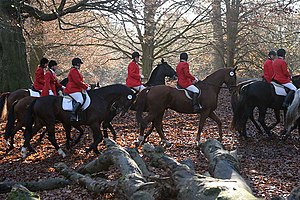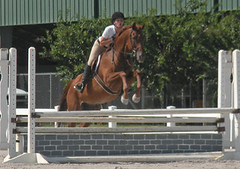Don’t go Off Course Again, 5 Short Cuts to Remembering Your Hunter Course

Show ring hunters were developed from the field hunters when they used to ride over natural obstacles. These days there are fewer coops, stiles and brick walls but the tradition of solid colour poles and more ‘natural’ fences remain.
In addition, because of the field hunter tradition, the courses are slightly different and less twisty and turny than a show jumping or stadium jumping course. A well designed hunter course should be:
- Built with the competition in mind.
- Inviting.
- Well constructed to encourage proper form of the horse.
Unlike a show jumping or stadium jumping course hunter courses have no numbers posted on each fence and you are not permitted to walk the course prior to you riding a hunter round. If you have trouble remembering your course keep these tips in mind.
- The course should flow steadily from one fence to the next without too

The Course Should Encourage Proper Form of the Horse (Photo credit: The Latest Slub:) much site seeing in between fences (unless of course, it is a handy hunter course – which is very windy to test the handy-ness of the horse!).
- The usual hunter course starts with a relatively easy first fence, usually going towards the ingate, on the 3/4 line, or inside line. This invitational fence should be an easy fence to encourage horses to jump and get the course ‘rolling’. Sometimes it is a brush fence or easy vertical.
- Most hunter courses are designed vertical—>oxer, vertical —->oxer so if there is an oxer at the beginning of a line, check your course. If you are aiming at the backside of an oxer then you may be off course.
- Most hunter courses have 8 fences and follow a simple pattern. For example,
- single invitational(1), outside line (vertical(2)—->oxer(3)), diagonal (vertical(4)—->oxer(5), outside line (6 – 7), single diagonal oxer (8).
- Remember your last fence. By having your last fence clearly identified in your head it will help you get the other jumps organized.
I knew of one coach who helped her students remember their course by telling them the courses were like making a sandwich. I over heard her tell her students, “outside piece of bread, peanut butter, jelly (diagonal, diagonal) then another piece of bread”, I thought it was brilliant they had a system worked up for her children to remember the course!
What strategies do you have in place to help your students get on top of their game and remember their courses?






 Try these three powerful exercises to get strengthen your position.
Try these three powerful exercises to get strengthen your position.

Too funny – if you’re heading to an oxer backwards you might be off course. I do recall one course where I forgot the last fence – and I was an adult no less. That will never happen again. This is a great tip sheet on the make up of a hunter course.